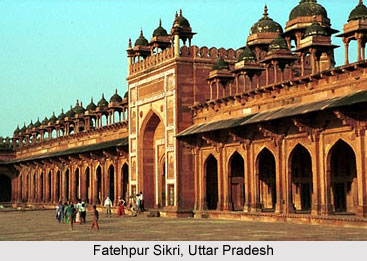 Islamic art in Northern India is spread over the states of the northern parts of India like Jammu and Kashmir, Punjab, Haryana, Uttar Pradesh and Delhi. The Delhi Sultanate and the Mughal dynasty in India had encouraged the introduction of Islamic style in Indian architecture and several other forms of art. Numerous mosques, tombs, minarets and other monuments in the country reflect a unique blend of Indo-Islamic art and Hindu, Buddhist or Jain architecture. Islamic art is quite popular in these parts, especially the places which were inhabited by Muslim communities.
Islamic art in Northern India is spread over the states of the northern parts of India like Jammu and Kashmir, Punjab, Haryana, Uttar Pradesh and Delhi. The Delhi Sultanate and the Mughal dynasty in India had encouraged the introduction of Islamic style in Indian architecture and several other forms of art. Numerous mosques, tombs, minarets and other monuments in the country reflect a unique blend of Indo-Islamic art and Hindu, Buddhist or Jain architecture. Islamic art is quite popular in these parts, especially the places which were inhabited by Muslim communities.
Islamic Art in Jammu and Kashmir
Jammu and Kashmir boasts of some mosques which are made of wood and covered with steeples, instead of domes. This was due to the fact that Muslims had imbibed Hindu architectural styles while constructing certain mosques in this state. Other types of Islamic art involve Shalimar Gardens, Begamabad Bagh, Nila Nag Bagh, Nishatbagh and Jami Masjid, Friday mosque located in Srinagar. The ancient art of weaving carpets and shawls are also among the prestigious Islamic arts of Jammu and Kashmir. The designs of carpets are influenced by Persian styles, and so are the motifs of the Kashmiri shawls.
Islamic Art in Punjab
Punjab`s Islamic architecture was inspired by the arts of Ghaznavide-Saljuqian. Several kinds of architecture in this state are of outstanding quality and boast of excellent building arts. Five tombs in Multan (which constitutes present-day Pakistan) are fine instances of Islamic arts in Punjab. Horizontal beams of buildings were engraved with brickwork and other household elements like windows, doors and doorways. Dexterous craftsmen in Punjab produced these masterpieces of Islamic arts.
Islamic Art in Haryana
Though the Indian state of Haryana possesses an insignificant quantity of Muslims, there are numerous reputable mosques here, whose architectural styles have been inspired by the past Muslim rulers. Important examples of Islamic art in Haryana are Dargah of Bu Ali Shah Qalandar and Lat ki Masjid.
 Islamic Art in Uttar Pradesh
Islamic Art in Uttar Pradesh
The Mughal Dynasty enabled the development of many types of Islamic arts in Uttar Pradesh. Several, forts, palaces, monuments and buildings speak of Indo-Islamic architectural wonders. The `Taj Mahal`, `Fatehpur Sikri`, Mughal gardens constructed by Babur, Agra Fort manufactured during the reign of Shah Jahan and others contain some of the most famous Islamic arts. Some of the temples located in Vrindavan display Islamic features since they were constructed during the rule of Mughal emperor Akbar. Other buildings which consist of Islamic architecture are Chhota Imambara, Jami Masjid and the Asafi Imambara.
Islamic Art in Delhi
The Delhi Sultanate introduced innovative styles of arts and architecture which were Islamic in nature. Islamic art was combined with several Indian styles, which consequently produced many beautiful structures in the city. The style of domes made an advent into the nation due to the patronage of these Muslim rulers. The most perfect dome is believed to be that of the renowned monument, Taj Mahal. Several magnificent domes can be observed in the Mehrauli area of Delhi. The architecture of some of the historical buildings in Delhi has been influenced by Persian styles.
Islamic art in the country developed during the seventh century. It includes innumerable kinds of art forms in different fields like painting, calligraphy, ceramics and architecture. However, Islamic art is not only restricted to the religion of Islam but comprises the varying types of Islamic culture too.



















